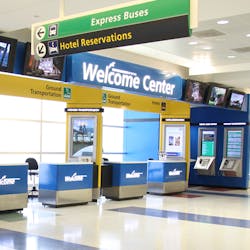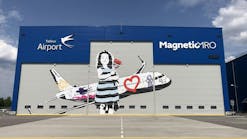Airport terminals of the mid to late 20th century – aging infrastructure reminiscent of a more utilitarian era before connectivity and major security initiatives – are now being replaced in abundance with modern, intuitive architecture, higher ceilings, expansions, and passenger-centric environments. Most passengers just want to get to their destinations quickly as possible. But now, airports are becoming destinations in and of themselves. Besides increasing passenger capacity and efficiency of the travel process, new terminals are places of self-sustaining revenue that attract and engage passengers. The modern airport cannot rely on aeronautical revenue alone to generate a profit. Creating an engaging and connected commercial space inside the terminal is an essential measure to drive revenue.
Building the airport of the future not only means meeting security needs, but also creating a place to which passengers want to return. This means building an engaging environment where the passenger feels excited about travel, their surroundings, and, hopefully, spending a little money. Gone are the days when the airport could rely on impulse buys from passengers who just wanted souvenirs or neck pillows. Airports today are seeking to create an omni-channel retail experience, where their onsite retailers have a deeper understanding of travelers’ needs and behaviors through the use of modern technology, such as mobile apps, digital signage, and beacons with which to engage potential purchasers.
Airports which continue innovating to respond to the increasing needs of passengers see overall positive passenger experience rise and non-aeronautical revenue grow.
Our firm suggests that our airport clients offer amenities such as mobile device charging stations and “Welcome Centers” to make travelers feel safer and more connected. Parabit has built 19 of these centers in several terminals at JFK, LaGuardia, Newark, and Stewart airports for the PANYNJ. The Welcome Centers incorporate digital signage, kiosks, ATMs, telephones and directories, and other technology within a custom-built enclosure. Digital signs display interactive, engaging images, advertisements, and electronic brochures that feature information on attractions and events in the area, all of which assist in growing onsite revenue.
LAX Bradley Terminal, which recently added several unique audio-visual features to attract and engage passengers, spent $737 million to create the world’s largest interactive multimedia experience in a public space. One feature is an 80-foot-tall media wall, called the Welcome Wall, where passengers will be greeted by uplifting images on their way to baggage claim.
The key to successful digital signage in any retail environment – and airports are no exception – is relevant content. It is imperative to align, plan and deliver relevant content to the right customer at the right time. Technology should tie in with trends in social behavior – everything on demand, where passengers have control of their experiences. Opt-in mobile technology and beacon technology is a simple, cost effective way to have multiple engagements with passengers on their journey from gate to curbside.
Targeted Digital Messages
Digital signage content can also be targeted for a specific audience. Content should be fresh and relevant - audiences tune out static posters whether they are traditional or digital displays. Innovative camera technology can now detect the presence of human faces and change content based on age and gender. The cameras can also track how long someone stays and engages with the interactive signage. Cameras are necessary for this function. Metrics to consider include view counts, conversion rations, dwell time, attention time, glances, as well as age, gender, and multiple engagements. A more cost-effective way to count viewers is a motion sensor, which can record how many times the signage has been approached, and can also record dwell time, but not the difference between a unique visitor and a repeat visitor. A camera is best to capture all metrics for a robust report.
Internet of Things (IoT) to Improve Reporting and Operations
Airport operations are starting to utilize free flowing data ecosystems involving the Internet of Things, a web of devices/objects that are provided with unique identifiers and the ability to transfer data over a network without requiring human-to-human or human-to-computer interaction. This creates seamless communication and breaks down interdepartmental silos. Security is connected to retail and passenger experience via a web of connected devices.
With the advent of mobile technology, passengers have come to expect a more connected experience. It is possible now for retailers to target passengers with relevant offers and communications via mobile apps.
Opt-In Applications (apps that deliver specials and increase loyalty) are a great way for airport retailers to reach passengers. Beacon Technology (push technology that sends passengers communications on their mobile devices with targeted offers, based on their geo-location) can also play a role. Adding beacons to digital signage kiosks can engage the passenger on multiple channels. Beacons can also send messages sent to mobile devices when baggage arrives, a flight is on time or delayed, and hotel reservations are confirmed.
A Rewards Program to attract and retain airport frequent flyers can also be done through a mobile website or app – where passengers receive an automatic thank you message for visiting terminal and points for coming back – as another way to engage passengers and increase loyalty.
In essence, the airport passenger is an on-the-go consumer, but also an individual human being who seeks comfort, and entertainment. It is an exciting time to develop superior airport operations, and to also increase non-aeronautical revenue, with new technologies. This can only improve the passenger experience at every airport touchpoint.
As a member of the Digital Signage Federation (DSF), author Georgia Reid will be a panelist on the DSF’s April “Hangout” discussion entitled, “Digital Signage and Environmental Design,” on April 13 at 2 p.m. EST. More information on this and other DSF events can be found on the DSF website. Both DSF members and non-members may join this or any of the DSF’s scheduled Hangout discussions for free – but registration is required and can be accessed on the DSF website at http://digitalsignagefederation.com/event-2175247
Georgia Reid is marketing strategist for Parabit Systems, a mid-size technology manufacturer whose product line includes kiosks, software solutions, proprietary digital signage, access control, and specialty cameras. Ms. Reid has over 13 years experience in writing, marketing, and enhancing the customer experience and is adept at launching new products and companies having previously worked in marketing for an IT re-seller (products included SaaS, Oracle, Dell, HP, IBM products).






